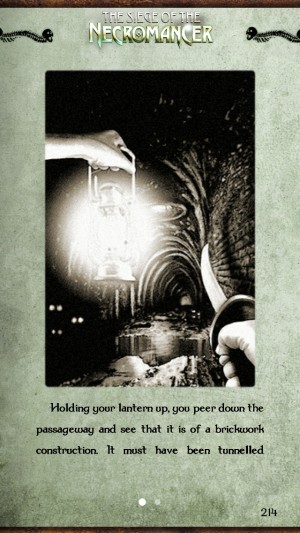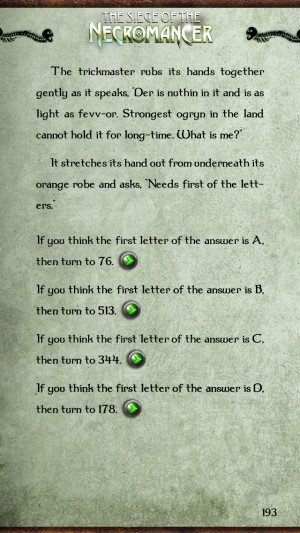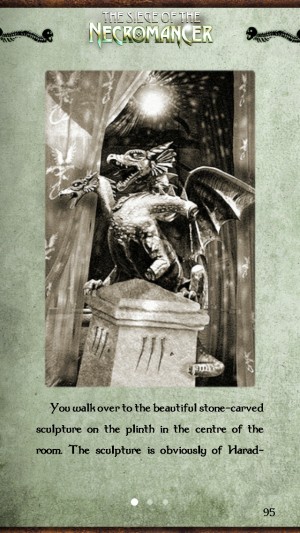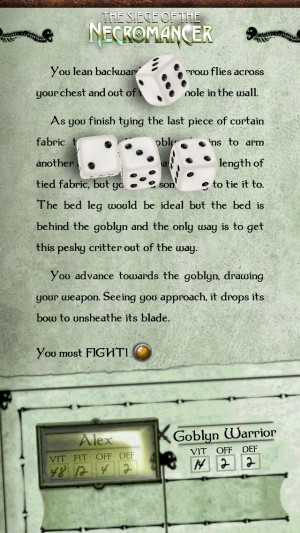 Hello, gentle readers, and welcome to the RPG Reload, the weekly feature where we require regular fitness checks to avoid instant death. In this weekly feature, we take a look at an RPG from the App Store’s past to see how it fares in modern times. It’s a chance to revisit old favorites, reflect on a game’s place in the overall pantheon, or just to take a deeper dive than our reviews typically allow for. As party leader, it’s up to me to choose the schedule from week to week, and I do my best to keep it balanced. That said, if you feel something is missing, please let me know by making a comment below, posting in the Official RPG Reload Club thread, or by tweeting me at @RPGReload. I schedule pretty far in advance, so you may not see your suggestion for a while, but I will add it to the master list.
Hello, gentle readers, and welcome to the RPG Reload, the weekly feature where we require regular fitness checks to avoid instant death. In this weekly feature, we take a look at an RPG from the App Store’s past to see how it fares in modern times. It’s a chance to revisit old favorites, reflect on a game’s place in the overall pantheon, or just to take a deeper dive than our reviews typically allow for. As party leader, it’s up to me to choose the schedule from week to week, and I do my best to keep it balanced. That said, if you feel something is missing, please let me know by making a comment below, posting in the Official RPG Reload Club thread, or by tweeting me at @RPGReload. I schedule pretty far in advance, so you may not see your suggestion for a while, but I will add it to the master list.
Now that October is upon us, we’re once again celebrating Hallowe’en here in the RPG Reload, with all of this month’s picks being spooky or scary somehow, as judged by me, the self-appointed Pumpkin Prime Minister. Last year, we covered a few of the more obvious ones, but there are actually quite a few horror-themed RPGs on the App Store for us to choose from. I hope you’ll enjoy our little celebration of one of my very favorite holidays.
 This week, we’re taking a look at one of the earlier gamebooks from the prolific publisher Tin Man Games. The series is on hiatus now as of the release of the twelfth book, Asuria Awakens ($5.99), so now is as good a time as any to cover it in this feature. If it were any other month, I probably would have picked An Assassin In Orlandes ($5.99), the first release in the series, but since it’s Hallowe’en Month, I’ve skipped ahead to the second book in the series, the more thematically-appropriate The Siege Of The Necromancer ($5.99). Released in June of 2010, it’s one of the earlier original gamebook releases on the App Store, but you sure wouldn’t know it by looking at it. The game naturally uses the Gamebook Adventures engine that has powered virtually all of Tin Man’s releases. The engine perhaps lacks a bit of flair compared to more contemporary takes on gamebooks, and Tin Man is soon going to be introducing a new engine to carry them into the future, but it does a fantastic job at the purpose for which it was created.
This week, we’re taking a look at one of the earlier gamebooks from the prolific publisher Tin Man Games. The series is on hiatus now as of the release of the twelfth book, Asuria Awakens ($5.99), so now is as good a time as any to cover it in this feature. If it were any other month, I probably would have picked An Assassin In Orlandes ($5.99), the first release in the series, but since it’s Hallowe’en Month, I’ve skipped ahead to the second book in the series, the more thematically-appropriate The Siege Of The Necromancer ($5.99). Released in June of 2010, it’s one of the earlier original gamebook releases on the App Store, but you sure wouldn’t know it by looking at it. The game naturally uses the Gamebook Adventures engine that has powered virtually all of Tin Man’s releases. The engine perhaps lacks a bit of flair compared to more contemporary takes on gamebooks, and Tin Man is soon going to be introducing a new engine to carry them into the future, but it does a fantastic job at the purpose for which it was created.
Tin Man Games is an Australian game developer founded by Neil Rennison in 2008. Before Tin Man, Rennison had run a game art outsourcing company in the United Kingdom called Fraction Studios. The company primarily worked on racing games for (at that time) relatively low-powered hardware, including the Nintendo DS and Sony PSP handhelds, and the PlayStation 2 and Nintendo Wii consoles. After saving up some money from that venture, Rennison and his wife relocated to Australia, where Tin Man was founded. Like many smaller developers at that time, Rennison saw potential in the recently-launched iPhone, and worked together with a programmer to release a few small-scale arcade-style games. Even back then, it could be hard to get noticed, and that’s just what happened with Tin Man’s initial efforts. Seeking a better business model, Rennison thought back to the beloved Fighting Fantasy gamebooks of his childhood, which had been more or less rendered extinct by video games. Feeling they would work well on the iPhone, he decided to pursue the Fighting Fantasy license to make iPhone conversions of the paper books.
Rennison approached Steve Jackson about the rights, and was disappointed to find that the rights had already been offered to a Canadian developer by the name of Big Blue Bubble. Tin Man would eventually secure the license after Big Blue Bubble’s contract expired a few years later, but for the time being, the developer would need something else. Rennison joined forces with coder and film industry veteran Ben Britten to create Gamebook Adventures, a Tin Man original series set in the world of Orlandes. Orlandes, like the settings found in many other RPGs, was born out of Dungeons & Dragons games of times past. When Rennison was young, he used to run D&D campaigns with his friends, taking the role of the dungeon master. He had created a fairly fleshed-out world in those days, and so on a trip back to his parents’ house in the UK, the adult Rennison crawled into the attic to fish out the product of the teenage Rennison’s imagination: a box filled with scribblings, notes, and a map that you can view in the Gamebook Adventures apps themselves.
 The initial plan for Gamebook Adventures included six books. The first two could be done on the resources Tin Man had remaining, while the others were created with funding assistance from Film Victoria. Rennison planned to write the first book himself, and brought on five writers to work on the others. Most of the writers were fixtures of the online Fighting Fantasy community, and Rennison basically had them pitch their own ideas for stories. Once the stories were settled on, Rennison would work with the writers to figure out where each story took place in the world of Orlandes, and how the continuity might connect over time. His inspiration for this aspect of the series came from his long-time admiration for Star Trek and its approach to continuity. This way, the writers could tell the stories they wanted, and fans could enjoy the ways things would fit together, even if a lot of that was happening in the background.
The initial plan for Gamebook Adventures included six books. The first two could be done on the resources Tin Man had remaining, while the others were created with funding assistance from Film Victoria. Rennison planned to write the first book himself, and brought on five writers to work on the others. Most of the writers were fixtures of the online Fighting Fantasy community, and Rennison basically had them pitch their own ideas for stories. Once the stories were settled on, Rennison would work with the writers to figure out where each story took place in the world of Orlandes, and how the continuity might connect over time. His inspiration for this aspect of the series came from his long-time admiration for Star Trek and its approach to continuity. This way, the writers could tell the stories they wanted, and fans could enjoy the ways things would fit together, even if a lot of that was happening in the background.
Rennison’s book was The Siege Of The Necromancer, a story he had started writing some time prior just for fun. He was so busy working on organizing everything, however, that the writer of what was meant to be the second book actually beat him to the finish line. Thus, An Assassin In Orlandes became the first release, and with that finished, Rennison was able to quickly finish off Siege as the second installment. One of his goals in writing the book was to make it as different as possible from Assassin, as he wanted to demonstrate that any kind of story could happen in the Gamebook Adventures series. He was also partly inspired by the Ian Livingstone Fighting Fantasy book Deathtrap Dungeon, which was a favorite of his. His first child was born while he was writing the book, and he mentions the odd feeling of looking at his wife and newborn daughter sleeping peacefully while he was hammering out grisly descriptions of goblyn deaths on his laptop.
Before going into Siege Of The Necromancer as a game, I have one last bit of trivia, a bittersweet tale of what could have been. This book was originally meant to get a companion story. In Siege‘s story, your main character can come across four different dead guards who had been tasked with spiriting away magical rubies. A Guard’s Tale would have cast you as one of those guards, with different endings that would have you die in the way one of the guardsmen in Siege did. Although it’s partly finished, this story has been put on the shelf, along with a few other ideas for additional Gamebook Adventures. Now that Tin Man has licenses like Fighting Fantasy, Warhammer 40K, and others under its belt, Orlandes can rest peacefully for a while. Its creator hopes to see it come back again one day, though, so I imagine we haven’t rolled our last fitness checks by any means.
 In terms of gameplay, the Gamebook Adventures don’t differ greatly from Fighting Fantasy for the most part. The battle system calculates things slightly differently, the stats have different names, and the challenges are a bit fairer than in many of the classic Fighting Fantasy books. While Fighting Fantasy eventually stretched its legs out to more exotic settings and situations, it usually abandoned the world of Titan to do so. The Gamebook Adventures all take place in one continuity, but still offer many kinds of tales, including straight-up fantasy action, detective stories, tense heist missions, and more. Siege Of The Necromancer mostly falls into the fantasy-action category, with a lot of fighting and exciting set pieces. It also has a few devious puzzles, a very difficult item hunt, and some elements of horror as well. On balance, it’s probably the most difficult of the Gamebook Adventures. While I can typically solve a gamebook after two or three tries, I think it took me at least a dozen runs before I could finally crack this one, and even then, I didn’t find all of the pieces that would have granted me some nice loot.
In terms of gameplay, the Gamebook Adventures don’t differ greatly from Fighting Fantasy for the most part. The battle system calculates things slightly differently, the stats have different names, and the challenges are a bit fairer than in many of the classic Fighting Fantasy books. While Fighting Fantasy eventually stretched its legs out to more exotic settings and situations, it usually abandoned the world of Titan to do so. The Gamebook Adventures all take place in one continuity, but still offer many kinds of tales, including straight-up fantasy action, detective stories, tense heist missions, and more. Siege Of The Necromancer mostly falls into the fantasy-action category, with a lot of fighting and exciting set pieces. It also has a few devious puzzles, a very difficult item hunt, and some elements of horror as well. On balance, it’s probably the most difficult of the Gamebook Adventures. While I can typically solve a gamebook after two or three tries, I think it took me at least a dozen runs before I could finally crack this one, and even then, I didn’t find all of the pieces that would have granted me some nice loot.
The premise has you returning to your hometown after a summer away working as a miner. Along with a few other people from the same city, you’re excited to be heading back home and reuniting with your family. When you reach the city, however, it’s apparent that something is wrong. The city is burnt, and the streets are infested with goblyns led by a wicked necromancer named Erid Buul. They’re desperately seeking something, but what could it be? Is your family safe, or are they among the many victims of this invasion? The answers can only be found in the city stronghold, which has been taken over by Erid Buul and his army of monsters.
Relative to later gamebooks in the series, Siege Of The Necromancer can be pretty short. The game has two collection subquests with some very useful rewards, but neither one is mandatory for finishing the quest. You’re also not afforded quite as much freedom to retrace your steps, and with few clues as to what path will lead where on your first playthrough, it’s essentially down to luck as to whether you’ll have a very short, incredibly difficult path, or a longer, slightly easier one. No matter which route you find yourself on, there are plenty of battles, lots of checks against your fitness score, and unless you’ve played before or somehow landed on the golden path by chance, a lot of objects and doors you won’t be able to do much with. This might seem unfair, but keep in mind that this was written in the manner of the classic Fighting Fantasy gamebooks, where you were meant to make multiple attempts to piece together the right strategy for success. Siege‘s brevity works in its favor because of this. You’ll certainly be making several trips through the stronghold, but even if you perish near the end, it’s not a terrible burden to make your way back there again.
It’s very densely-packed for its length, though. There are a bunch of fun puzzles to solve, and the tricky nature of the treasure hunts will have you thirsty to check out every detail in every room. As I’ve already mentioned, there’s a lot of action in the game, too. The last couple of battles are grand in their scope and challenge, and there’s enough fodder mixed in with the tough creatures you’ll meet along the way to make you feel suitably powerful. It’s easy to see Rennison’s tastes through his design and writing style. While the things you come across could easily make for a story of horror or at least desperate survival, Siege Of The Necromancer feels like a 1980s fantasy action story more than anything else. Your enemies are terrible and powerful, but you can give just about as good as you get. There are a few strange characters you can choose to deal with in less violent ways, and the rewards for doing so are more than worth it.
 Like all of Tin Man’s games, if you just want to enjoy the content without the stress, you can choose an easier difficulty setting. While other electronic gamebook developers have used a variety of ways to approach the genre’s infamously high difficulty, I kind of like how simple and straightforward Tin Man’s approach is. You can play the game on casual and more or less cheat your way through the book, healing when you like, opening up choices even if you shouldn’t be able to, and using an unlimited supply of bookmarks to quickly skip around the book. You can take a step back anytime you like, so even if you die, you can just go back and try something different, which is, realistically, what most players did with the old physical gamebooks. The middle difficulty setting gives you unlimited bookmarks and nearly maxed stats, but otherwise has you play the game normally. If those both sound too easy, you can go with the classic difficulty setting, which gives you a generous allotment of six bookmarks, but no other benefits. I think the game can be fun on any difficulty setting, but I encourage experienced RPG fans to give it a go on at least the middle setting.
Like all of Tin Man’s games, if you just want to enjoy the content without the stress, you can choose an easier difficulty setting. While other electronic gamebook developers have used a variety of ways to approach the genre’s infamously high difficulty, I kind of like how simple and straightforward Tin Man’s approach is. You can play the game on casual and more or less cheat your way through the book, healing when you like, opening up choices even if you shouldn’t be able to, and using an unlimited supply of bookmarks to quickly skip around the book. You can take a step back anytime you like, so even if you die, you can just go back and try something different, which is, realistically, what most players did with the old physical gamebooks. The middle difficulty setting gives you unlimited bookmarks and nearly maxed stats, but otherwise has you play the game normally. If those both sound too easy, you can go with the classic difficulty setting, which gives you a generous allotment of six bookmarks, but no other benefits. I think the game can be fun on any difficulty setting, but I encourage experienced RPG fans to give it a go on at least the middle setting.
Being one of Tin Man’s earliest releases, Siege Of The Necromancer has received quite a few updates over the years. The difficulty settings weren’t in the original version of the game and have actually been reworked a couple of times to arrive in their current forms. As the app predates both iPhone 4 and the iPad, it was updated for universal and retina support through as the new hardware released. It also received a new intro in its most recent update, which was in September of 2013. As you might expect, the game still runs perfectly well on modern hardware and iOS versions, though it lacks native support for the iPhone 6 family. The first Gamebook Adventures got a recent update to that end, but it’s hard to say if and when Tin Man will be able to do that for the others in the series. Still, it works perfectly well, and is enjoyable both as a pocket game on the iPhone or as a book-sized treat on the iPad.
The Siege Of The Necromancer might not be scary enough to get you in the exact mood for Hallowe’en, but there are plenty of encounters with hostile undead, making it a suitable appetizer for the season. It’s tough as nails, but it’s also rather absorbing once you get into the process of unraveling it. This was a very early effort for Tin Man, and their work obviously improved with time, but like the rest of the Gamebook Adventures, it’s worth a play now and then just to enjoy its rich setting and enjoyable design. Who knows? You might actually beat it on classic difficulty sometime.
Those are just my feelings on The Siege Of The Necromancer, though. What do you all think? Please let me know by commenting below, posting in the Official RPG Reload Club thread in the forums, or by tweeting me at @RPGReload. I also encourage you to check out the latest episode of the RPG Reload Podcast, which went up earlier this week. If you have any questions you’d like us to answer on the podcast, you can send them to [email protected]. As for me, I’ll be back next week with another spooky game that runs at a slightly different pace. Thanks for reading!
Next Week’s Reload: Solomon’s Boneyard (Free)